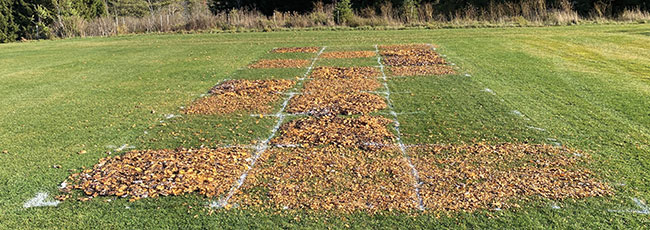
Features
Earth Week
Eco-Friendly Soils
Fall/Winter Preparations
Municipal
Research: Lawn quality at risk during leaf cover
“No Mow May” and “Leave the Leaves” campaigns challenged through study
March 17, 2023 By Dr. Sara Stricker and Dr. Eric Lyons
 Researchers at the GTI expect to see a decrease in turf quality in plots covered with leaves.
Photo: Guelph Turfgrass Institute
Researchers at the GTI expect to see a decrease in turf quality in plots covered with leaves.
Photo: Guelph Turfgrass Institute Have you seen the slogans? Signs may appear in your neighbourhood declaring: LEAVE THE LEAVES, NO MOW MAY or SKIP THE RAKE. These campaigns have popped up in North America in recent years, pledging to increase biodiversity or support pollinator insects. The experts at the Guelph Turfgrass Institute want to weigh in on this debate.
“No Mow May” started in the U.K. with the idea that the lawn can provide food to pollinators in the early spring through the flowering weeds. The other campaign, “Leave the Leaves” (also called “Skip the Rake”), suggests that leaves should be left untouched on the lawn surface to provide overwintering niches for pollinators and other beneficial insects. However, too much leaf cover could lead to smothering and death of the turf.
Both practices would theoretically increase biodiversity in a home lawn, but the final outcome may be less desirable than expected. We theorize that both campaigns will be detrimental to the home lawn – possibly increasing the presence of undesirable weeds and eventually leading to homeowner frustration and an unusable lawn. In addition, increased biodiversity may also mean an increase in unwanted pests such as ticks, mites, and rodents.
One study, which has since been retracted from publication, suggested that lawns participating in No Mow May had greater pollinator diversity and abundance to mowed urban green spaces (Del Toro and Ribbons, 2020). Unfortunately, the study compared un-mowed home lawns to parks, which is not a valid comparison. Home lawns typically have more diversity than parks, due to their closer proximity to flower beds, flowering trees, and hedges. A better comparison would have been to compare lawns participating in No Mow May to lawns that were not.
In a new study at the Guelph Turfgrass Institute, we will be observing lawn-height turf (Kentucky bluegrass, chewings fescue, perennial ryegrass mix) which has either been covered with Norway maple leaves (approximately five centimetres deep), raked clear, or covered with Norway maple leaves which were then mulched by a lawnmower. In the spring of 2023, half of these plots will be left UN-MOWED until June 1, thus simulating both the No Mow May campaign and Leave the Leaves. Turf quality, weed encroachment, and disease pressure will be evaluated.
We expect to see a significant decrease in turf quality for the plots covered with leaves, and we might see an effect of fertilization from the mulched leaves. Dr. Paul Koch at the University of Wisconsin is conducting a similar trial on different depths of leaf cover (five or 15 centimetres, mulched or not mulched) to test effects on turf quality and soil health over the next few years.
It is important to consider that mowing less frequently can create breeding ground for unwanted insects such as mosquitos, ground-nesting bees and ticks, so please keep an eye out and prevent kids and pets from entering areas of long grass.
Supporting a diverse ecosystem is important, but we also want to maintain the usefulness and ecosystem services provided by a healthy lawn.
Ways to support pollinators and increase biodiversity in urban spaces:
- Add pollinator-friendly flowers, trees, and shrubs to the yard – early season flowers include serviceberry, willow, and lilac
- Overseed your lawn with white clover and creeping buttercup, although note that these could overtake the lawn
- Plant crocus bulbs into a lawn to provide pollen in March and April, since the flowering period is typically finished before the grass needs its first trim
Dr. Sara Stricker is communications and outreach co-ordinator at the Guelph Turfgrass Institute. Dr. Eric Lyons is director at the Guelph Turfgrass Institute.
This article is part of the Fall & Winter Prep Week Week.
Print this page